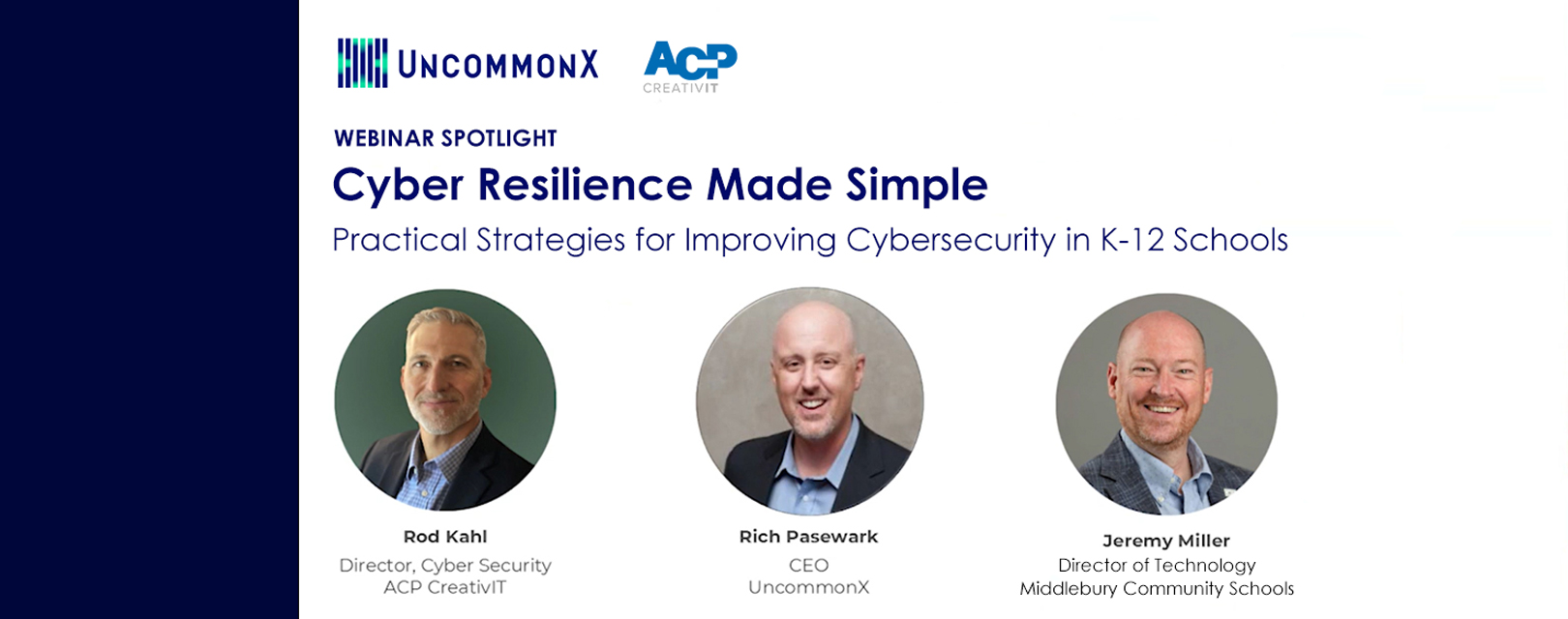WEBINAR SPOTLIGHT: Practical Strategies for Improving School Cyber Resilience
The cybersecurity landscape in K-12 schools has reached a pivotal point. Despite growing threats, many schools find themselves underprepared, with a...
Experiencing an active breach? Call us immediately at 1-866-405-9156 UncommonX has experienced ZERO reportable breaches.
5 min read
 Rich Pasewark - CEO, Board Director
:
May 30, 2024 4:29:21 PM
Rich Pasewark - CEO, Board Director
:
May 30, 2024 4:29:21 PM

As the 2023/24 school year draws to a close, many districts are taking stock of the surge in cyber attacks that targeted educational institutions throughout the year. Cultivating a cyber resilient school culture is not just advisable; it's imperative.
According to the May 2023 CoSN State of EdTech Leadership report, cybersecurity remains respondents’ top priority for the fifth year in a row. However, 66 percent of school districts do not have a full-time cybersecurity position, and more than one in five have no funding for cybersecurity defense.
"When we were hit back in 2019, we actually thought we were in pretty good shape, not really knowing that we weren't. And it became painfully obvious after our attack that we were really not prepared for anything like that."
— Jeremy Miller, Director of Technology, Middlebury Community Schools
This blog post explores practical, affordable strategies for developing that culture, with insights on how UncommonX's commitment to cyber resilience and its MDR (Managed Detection and Response) for Education solution can be integral in this endeavor.
Understanding Cyber Resilience in Education
Cyber resilience refers to an organization's ability to continuously deliver the intended outcomes despite adverse cyber events. For K-12 schools, this means maintaining the confidentiality, integrity and availability of educational data and systems.
While schools await a vote on the $200 million FCC pilot program to bolster cybersecurity funding, K-12 schools are already underfunded by an estimated $150 billion annually in the U.S. At a time when schools are having to do more with less, strengthening policies, behaviors and technologies internally among students, faculty and staff can make a meaningful difference.
Developing a cyber resilient culture involves more than just deploying the right technology. It requires a holistic approach, integrating robust cybersecurity practices into every facet of the school environment, including its people and policies.
Building the Foundation: Policies and Governance
The first step in fostering a cyber resilient culture is establishing clear cybersecurity policies and governance structures. Schools need to define policies that cover acceptable use of technology, data protection guidelines, incident response protocols and regular audits. These policies should be regularly reviewed and updated to adapt to new cybersecurity challenges and regulatory requirements.
Several free resources are available to help schools define these policies. For example, the Cybersecurity & Infrastructure Agency(CISA) offers complimentary resources, such as toolkits and tabletop exercises. You can access those here.
Cultivating Awareness and Behavior Change
Awareness is the cornerstone of a cyber resilient culture. Educating students, faculty and staff about cybersecurity risks and best practices is crucial. This can be achieved through regular training sessions, workshops and engaging e-learning modules. Topics might include recognizing phishing attempts, securing personal and professional data, and understanding the importance of software updates. Schoolsafety.gov offers a number of free resources to K-12 schools online.
Behavior change is fostered by making cybersecurity part of the school’s ethos. For example, acknowledging Cybersecurity Awareness Month when students return in the fall, creating visual reminders about secure practices, and integrating cyber hygiene tips into daily announcements can reinforce the importance of cybersecurity.
Leveraging External Partners Effectively
While fostering awareness and setting policies are critical, the technological backbone of cyber resilience cannot be overlooked. Schools should invest in cost-effective cybersecurity solutions that can detect, respond to, and recover from cyber incidents. UncommonX’s MDR for Education solution offers advanced threat detection and response capabilities. It uses a combination of cutting-edge technology and human expertise to monitor school networks 24/7, quickly identifying and mitigating potential threats. This proactive approach not only protects sensitive information but also educates IT staff on evolving cyber threats, enhancing overall resilience.
Our Security Operations Center (SOC) team, powered by the UncommonX platform, monitors and stops the root causes of threats. You get 24/7 inside-out protection no other platform or provider can offer.
 |
Complete network visibility: UncommonX's technology maps the entire network, infrastructure, and devices, ensuring no part of the school's digital environment goes unmonitored. |
 |
Rapid deployment: UncommonX's solutions are designed for quick and easy implementation, meaning schools can have their next 24/7 SOC up and running well before the next holiday break begins. |
 |
Expertise on demand: UncommonX's 24/7 managed SOC team acts as an expert extension of a school's IT department, ready to contain and remediate any cyber risks that arise, ensuring the network remains secure and optimized. |
Creating a Responsive Environment
Developing a responsive environment involves establishing a proactive incident response plan. Schools must have clear procedures in place for responding to cybersecurity incidents. This includes identifying roles and responsibilities, outlining steps for containment and eradication, and communicating with affected parties. Regular drills and simulations can help ensure that the school community is prepared to act swiftly and effectively when a real incident occurs.
This topic was discussed in depth during our recent webinar titled: Practical Strategies for Improving School Cyber Resilience, which highlighted several internal best practices and proactive measures, many of which do not require additional funding.
"There’s never a good time to start [improving cybersecurity], but the worst time to start is when you have an incident happening."
— Richard Pasewark, CEO, UncommonX
12 Steps for Building Cyber Resilience in Schools
|
|
Conduct Regular Risk Assessments: Identify vulnerabilities in the school’s network and systems by conducting regular risk assessments. This will help prioritize cybersecurity efforts based on potential impacts. |
|
|
Implement Strong Access Controls: Use multi-factor authentication (MFA) and role-based access control (RBAC) to limit access to sensitive information and systems only to those who need it. |
|
|
Update and Patch Systems Regularly: Keep all software and systems up to date with the latest security patches. Automated patch management systems can help streamline this process. |
|
|
Secure Mobile and IoT Devices: With the increasing use of mobile devices and IoT in schools, it's vital to ensure these devices are securely integrated into the network and regularly monitored for vulnerabilities. |
|
|
Develop and Enforce a Robust Cybersecurity Policy: Create clear policies regarding cybersecurity practices, including password management, device usage, and data handling. Ensure these policies are actively enforced and updated as needed. |
|
|
Educate and Train All Stakeholders: Conduct ongoing cybersecurity training for students, teachers, and staff. This training should include identifying phishing attacks, proper internet practices, and secure handling of personal and school data. |
|
|
Backup Data Regularly: Ensure that all critical data is backed up regularly and that backups are stored securely. Test recovery procedures to ensure they are effective in case of a cyber incident. |
|
|
Monitor Networks for Suspicious Activity: Use network monitoring tools to detect and respond to suspicious activity promptly. Consider services like UncommonX’s MDR for Education, which provide 24/7 monitoring and expert threat analysis. |
|
|
Establish an Incident Response Plan: Have a well-defined incident response plan that outlines specific steps to take when a cybersecurity incident occurs. Every member of the cybersecurity team should have a copy of this response plan, ready to grab, should an issue arise. Regularly review and practice the plan to ensure rapid and effective response. |
|
|
Engage with Cybersecurity Experts: Collaborate with cybersecurity experts and vendors who can provide the latest insights, tools, and support to protect against and respond to cyber threats. |
|
|
Leverage Community Resources: Engage with local government, law enforcement, and cybersecurity groups to stay informed about the latest threats and best practices. These partnerships can provide additional resources and support. |
|
|
Review and Refine Continuously: Cybersecurity is an ongoing process. Regularly review and refine cybersecurity strategies and practices to adapt to new challenges and technologies. |
Benefits of a Cyber Resilient School Culture
Developing a cyber resilient culture in schools is essential for protecting against the increasing threat of cyber attacks. By establishing robust policies, fostering awareness leveraging advanced technology like UncommonX’s MDR for Education, and creating a responsive environment, schools can defend themselves against cyber threats while nurturing an educational atmosphere that is secure and conducive to learning.
UncommonX remains committed to empowering educational institutions with the technology and knowledge to achieve and maintain cyber resilience, ensuring that the educational journey is both enriching and secure. To help, UncommonX recently created an ROI Calculator to help schools build stronger business cases for funding.
To speak with a member of our team, contact us at hello@uncommonx.com today.

The cybersecurity landscape in K-12 schools has reached a pivotal point. Despite growing threats, many schools find themselves underprepared, with a...

With summer break on the horizon, cyber threats are showing no signs of slowing down. In fact, several districts are using the final months of the...
In a significant move to address the growing cyber threats facing our nation's healthcare infrastructure, the White House has made a critical...